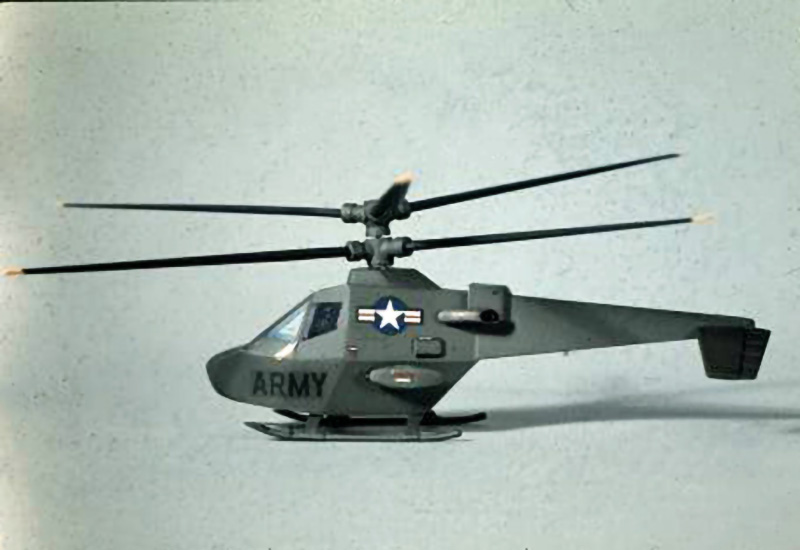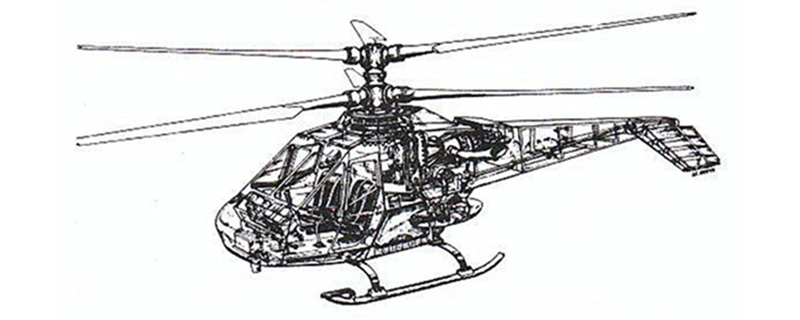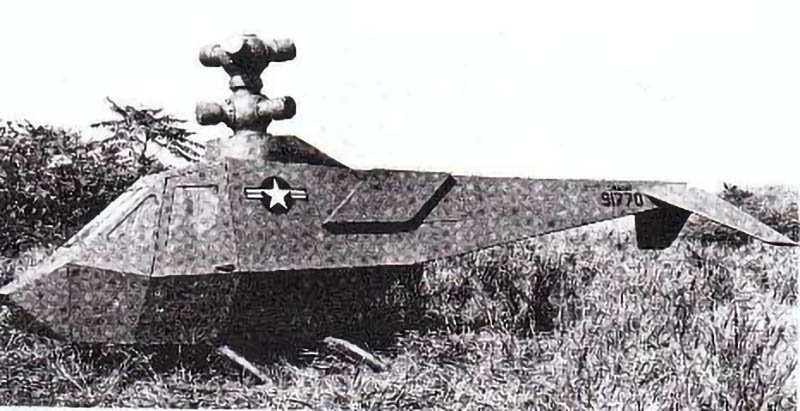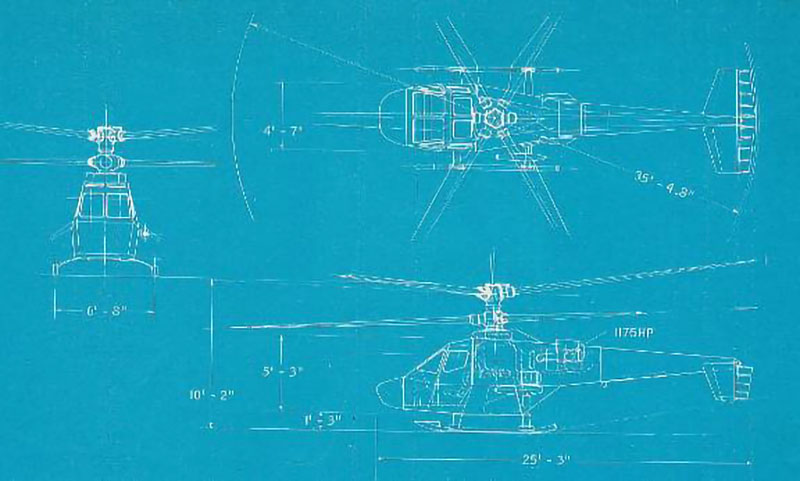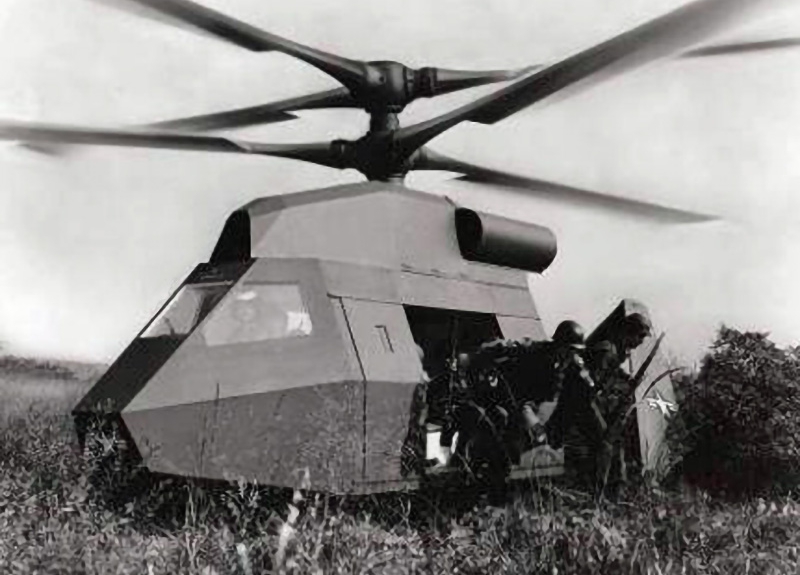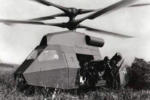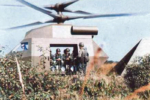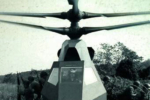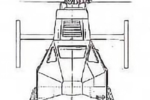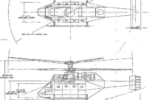Sikorsky Product History
Sikorsky Aerial Armored Reconnaissance Vehicle (AARV)
Background
In 1967 Sikorsky investigated new light-weight dual-hardness aircraft armor. This promised to be much lighter than the armor then available and more effective at defeating ballistic threats. In an unconventional approach, a concept was proposed to build a helicopter fuselage with this armor, rather that simply adding the armor parasitically around sensitive areas of the vehicle.
Concurrently, Sikorsky was in the early stages of developing the Advancing Blade Concept (ABC) for extending the speed range of helicopters. This used two very rigid counter-rotating rotors, allowing rotor lift at high speeds to migrate off the rotor centerline to the advancing sides of the rotor discs, thus eliminating retreating blade stall which limits the speed of conventional helicopters.
Although the proposed armor fuselage vehicles would not need the speed capability of the ABC, it was quickly recognized that the rugged ABC rotor head had benefits for ballistic tolerance. And ABC promised improved maneuverability over conventional helicopters. These two ideas were combined into an aircraft with an armor fuselage and an ABC rotor system.
The ABC had the additional advantages of not requiring a tail rotor, and a design where the control swashplates for the two rotors were buried below the rotors, both further reducing the vulnerable area of the aircraft against ballistic threats.
Two designs were considered. The first was a two place reconnaissance vehicle, the AARV – Aerial Armored Reconnaissance Vehicle – proposed as a follow-on to the Army’s light observation helicopters then in production, the Hughes OH-6A and the Bell OH-58A.
This project involved both Army and company funds over a two and a half year period. Army funding came from the Army Materials and Mechanics Research Center in Watertown, Mass, which was responsible for much of the development of the dual-hardness armor. In phase 1 of the contract manufacturing techniques, including methods for cutting, joining, forming and finishing the material, were evaluated. In phase 2, a simulated fuselage was fabricated and subjected to ballistics testing.
In these tests the armor plate was dented but not penetrated from shots of 30-cal ball at zero range and 50-cal weapons at longer ranges.
The program did not progress beyond these conceptual efforts. The testing of the full-scale ABC rotor system in the NASA Ames wind tunnel in 1970 was very successful, and the Army and the company decided that a high-speed research aircraft, evaluating the ABC’s speed potential, was more productive. This became the XH-59A, the subject of another chapter in this Sikorsky Product History section.
Configuration Features
The main fuselage of the AARV was to be constructed from half-inch thick dual hardness armor. The latest technology in transparent armor would be used for the aircraft windows. The tailcone and empennage would be conventional aluminum structure. The empennage was an inverted “V” to keep it under the rotor and minimize aircraft size. Elevators were included in the tail.
The armor would represent approximately 1,800 pounds of the aircraft’s 6,800 pounds gross weight.
By using armor plate as the primary fuselage structure one-third of the helicopter’s normal support structure was eliminated and it was projected that there would be a two-thirds reduction in production labor.
General Arrangement Drawing
General Characteristics and Performance
| AARV Characteristics and Performance | |
|---|---|
| Gross Weight | 6,800 lbs. |
| Payload | 1,000 lbs. |
| Rotor Diameter | 35.4 ft. |
| Powerplant | P&WA PT6 |
| Power | 1,175 hp |
| Maximum Speed | 150 kts. |
| Cruise Speed | 120 kts. |
| Endurance | 3 hrs. |
| Fuselage Length | 25.4 ft. |
| Fuselage Width | 4.5 ft. |
| Fuselage Height | 5.4 ft. |
Related Models
The same design approach was also considered for a larger AAPC, Aerial Armored Personnel Carrier, carrying twelve troops within the armored fuselage. The rotor diameter would grow to 40 feet, the same size as the ABC rotor being tested at the time in the NASA Ames wind tunnel.
Note on Nomenclature
Some non-Sikorsky references refer to the AARV as the Sikorsky S-68. This is not correct. The S-68 was a conceptual design for a small commercial aircraft using S-58T components. It never went beyond the concept stage.
Reference
Aviation Week & Space Technology, October 12, 1970, page 65, “Armor Used as Airframe for Helicopter”.
- by Art Linden


